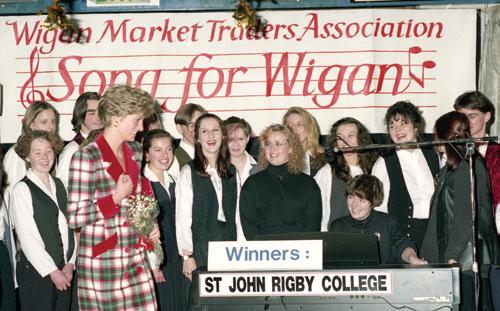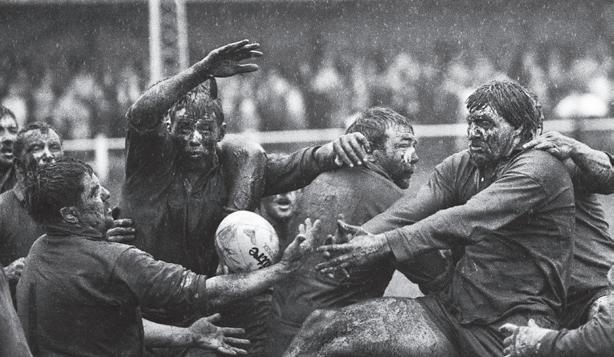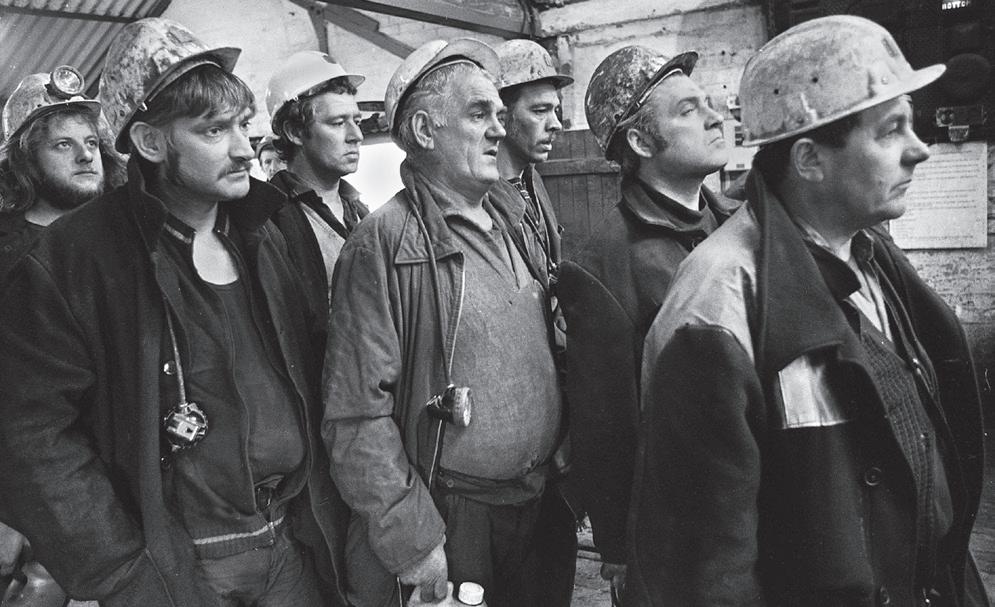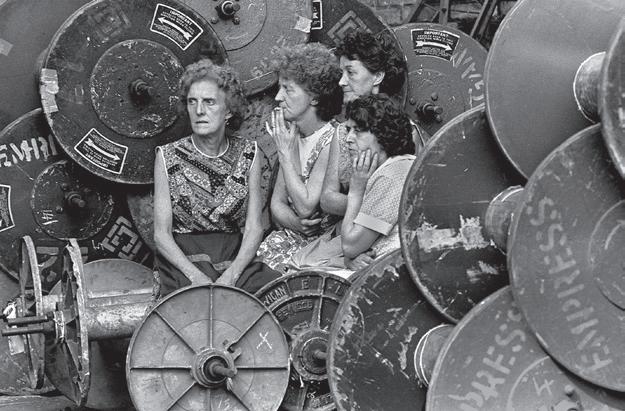
10 minute read
Through the Lens with Frank Orrell
Life through the lens
by Nicola Gray
Advertisement
Andy Warhol famously stated, the best thing about a picture is that it never changes, even when the people in it do. To capture and preserve a moment in history surely leaves you with many great memories of your own, so I caught up with Wigan lensman Frank Orrell, to ask him just that.
Frank has taken thousands of pictures of Wigan, the people who live here and local events, spanning a career of more than 40 years with the Wigan Observer. Frank started life at 84, Shevington Lane on 21st of January 1949 born to his Irish Mum, Foila, and Dad, Jim. Frank added, “I have a sister, Kathleen and a half sister, Ann. Ann’s mum died giving birth to her and my mum died of tuberculosis in 1954, my paternal Grandma, Annie, helped to bring us up while my dad was working as a joiner.”
Frank travelled about a bit in his younger years and spent some time in Ireland, “My Granddad, Thomas, had been killed in action on the Somme in the last months of the First World War. When mum was ill, Kathleen and I were taken to live in Corrinshigo, in Northern Ireland with our maternal grandparents. We were there for about a year.” When talking about some of his earliest memories, many of them centre around the happy times he spent in Ireland, but Shevington was always home, Frank added, “I remember coming home to a then very rural Shevington with few houses and hardly any traffic. Old Lane was just across from where I lived and as a child it was a bit scary, it was a mysterious and dark tree lined track.”
Bickershaw Festival, 1972

“I also remember that we didn’t have a television in those days but the Hilton family, who lived opposite us at Coach House Farm, did and would let me and my sisters watch Children’s Hour. I would spend most of the time asking who were the goodies and who were the baddies as the Lone Ranger, Cisco Kid and Range Rider rode across the screen.”
Frank attended St. Marie’s Catholic Primary School on Almond Brook Road in Standish and was taught by the nuns there. He says, “After passing my 11 plus I went to Blessed John Rigby Grammar School on Gathurst Road, which was run by the Christian Brothers order. I’m afraid to say I wasn’t as happy here as I was at primary school, the so-called Christian Brothers could be quite cruel and sadistic.”
On leaving grammar school, Frank had big aspirations of becoming a professional footballer, but football’s loss has been photography’s gain. He tells me, “Funnily enough I was never that interested in photography but my dad was a fairly keen amateur and because I’d no idea what I wanted to do after leaving school he suggested writing to the local papers to see if there was a vacancy for a photographer. They wrote back saying that there were no positions available at the time but would keep my name on file.”
Frank’s first job was a far cry from the craft he eventually made into his long-term career, “My first job was at Bradley’s menswear shop in Market Street, when I was sixteen. I went along to enquire about a job and the manager, appropriately named Mr. Wigan, was happy to take me on. Duties included sweeping the step in the morning, lighting the coal fire, and dusting the shirt boxes. I was never much good at selling socks, underpants and cardigans and after two years of measuring bellies and inside legs, I got a letter from the Post and Chronicle newspaper on Leyland Mill Lane, inviting me for an interview for a photographic printer.”

Frank underwent four years of training, including printing pictures in the darkroom and occasionally going out with photographers on assignments, he added, “I was promoted to photographer and given my first camera, which was a Yashica twin lens reflex. I grew to absolutely love the job and I have covered everything from news and sport to leisure events.”
Some of Frank’s proudest moments have come from his time behind the camera but his proudest moment came as a Dad, he tells me, “I won several newspaper photography awards but my proudest moments concern being able to get two spare photographer passes for my sons, Danny and Mike, for the 1992 rugby league Challenge Cup Final between Wigan and Castleford at Wembley. This was during Wigan’s eight-year dominance of Challenge Cup wins in a row from 1988 to 1995, the
Golborne Miners, 1979
lads were able to sit with me on the pitch looking after my photographic gear as I took the pictures. Just to cap the day Wigan won 28-12.” Frank has a deep affection for his hometown, and he has probably seen more of the place and people than most. When asked about Wigan he said, “It’s always been a friendly place and I think it’s quite attractive contrary to what people outside of the area may think. I love going for walks around Mesnes Park, Haigh Hall and in Elnup Wood in Shevington. Wigan has also been a great source of characters, stories, and pictures, happy and sad, throughout my career.”
And stories are what Frank has in abundance, and I can’t help but laugh as he regales me with the story about the time he was at the wrong end of Bernard Manning’s wit! “You could say that I had the dubious honour of being insulted by Mr. Manning. He was appearing at Poolstock Cricket Club in 1973 and I needed audience reaction pictures as Manning told his jokes on stage. I wasn’t in a good position at the side of the room to see their faces, so
Orrell v Gloucester I started to creep along in front of the stage to get a better angle. I was snapping away happily with my back to the stage when suddenly Manning stopped his act, leant over and asked me what I was doing.”


Frank tried to brush him off by telling him he was taking photographs, but spying the opportunity for a bit, Manning wouldn’t leave it alone. “‘What of?’ he asked me, so in true Wigan style I responded, ‘the audience not laughing at your jokes’, then I started to creep away, but he carried on. ‘You cheeky little toe rag. Bloody hell look at the state of him, look at the size of his nose, he could smoke a cigar under a shower’. Of course, the audience were in stitches and I didn’t hang around too long.”
Another incident that stuck in Frank’s mind was the time he went to take a picture of a charity cheque presentation at St. Mary’s Primary School in Lower Ince. Frank continued, “Nearly the whole school were in the assembly hall and I wanted to get as many of the pupils as I could on the photograph, but it was difficult from ground level so I dragged up a large vaulting box. I climbed on with camera and flashgun in hand and proceeded to snap away. Even from that height I wasn’t quite far enough back so I stepped backwards without realising that the box was sideways on, I tumbled over the back of the box and disappeared. The whole school were in uproar at my antics but luckily, I wasn’t hurt, and my photographic equipment survived. Just to add insult to injury as I was leaving a little lad said to me, ‘That was funny Mister, can you come back at Christmas?’”
When I ask about his most memorable image, I know it’s almost an impossible question to answer, but in true Frank style he says, “If I’m allowed to pick two or three images just to reflect the agony and ecstasy of life my most memorable images are a picture I took of redundant workers facing a bleak future in 1975, after it was announced that Empress cotton mill in Higher Ince, was to close. I pictured them looking forlorn between the huge empty cotton reels pondering their future.
“Another sad one was a picture that I took of the first miners going back to work just three days after the underground explosion that killed ten of their colleagues at Golborne Colliery in March 1979. A happier image was in the long hot summer of 1976 when Ince children made the most of the North West Water Authority testing a new water main to have some cool splashing fun.”
Summer, Ince, 1976 Empress Mill Closure, 1975

Frank took early retirement from his press photographer job in 2009 and started working on his self-published books. “I have nine books of photographs from my 42 years on the Wigan papers and am presently working on another book of photographs mainly from the 1960s. During lockdown I have been busy scanning negatives and photographs at home. It will probably be late this year before I can get it published.”

New Discoveries
It’s easy to get stuck in a rut when it comes to reading. We tend to choose genres that we know we’ll enjoy. But it can be good to try something new once in a while…
Quite
Claudia Winkleman Can’t stand books by celebrity authors? Try Quite. Reading it is a bit like putting the world to rights with your best mate over a glass of wine (or three). You’ll find out about everything from Claudia’s views on relationships and parenting to her thoughts on naps (essential) and brightly coloured clothes (to be avoided at all costs).
The Girl Who Drank the Moon
Kelly Barnhill Still turning your nose up at reading children’s fiction as an adult? You’re seriously missing out. Start with The Girl Who Drank the Moon. A baby is left in the woods as a sacrifice to a witch. But rather than kill her, the witch raises the child as her own. Meanwhile, the mother is left to go mad in the tower, where the real threat lies. Storytelling at its best.
Humans
Brandon Stanton Never bought a ‘coffee table book’ before? Humans won’t disappoint. It’s a difficult book to describe in a way that does it justice. Let’s just say that it’ll give you a glimpse of people’s lives across the globe. You’ll hear from people with differing viewpoints, discussing everything from the worst and best moments of their lives to everyday concerns. You’ll be uplifted, saddened and inspired and end up feeling just a little bit more connected to the rest of humanity.
Reality and Other Stories
John Lanchester If you haven’t read any ghost stories since your teenage years, Reality and Other Stories is a good place to start. From traditional ghost stories to Black Mirror-esque tales, each story is deliciously creepy and focuses on an aspect of modern life, from a twisted reality show to a possessed selfie stick. As you’d expect, some stories are stronger than others, but overall, it’s a decent collection to keep you occupied through these long winter nights.
The Night Bus Hero
Onjali Q. Raúf Ever read a book with an unlikable protagonist? Ten-year-old Hector is a bully. He can generally be found causing trouble or picking on someone smaller. But when he mistakenly accuses an innocent man of a crime, Hector has to decide whether to continue on his path or become the hero for once. Strictly speaking, this is another children’s book, but it’s likely to be enjoyed by anyone aged ten up.
A Single Thread
Tracy Chevalier As a genre, historical fiction is incredibly varied, covering as it does every period in the last few thousand years. A Single Thread focuses on the period between the two world wars. At thirty-eight, unmarried Violet is a ‘surplus woman’, with no real place in society. However, she also has what many married women at the time did not – freedom. When she starts embroidering kneelers for Winchester Cathedral, Violet finds a way to both connect with the world and make her mark on it.



